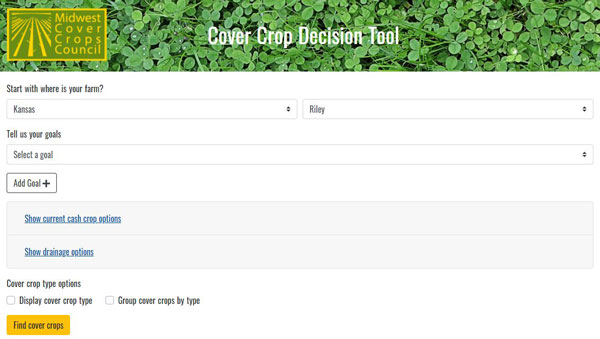Choosing the best cover crop for a particular cropping system can be difficult. Many factors are involved when selecting the most appropriate cover crop. The Midwest Cover Crops Council (MCCC) has released an improved cover crop selection tool to help farmers determine the best types of cover crops for their fields. The MCCC is made up of representatives from 12 Midwest states, the Canadian province of Ontario, and select universities, including Kansas and Kansas State University.
With this tool, users select their state/province and county and then select the goals they have for cover crops — erosion control, nitrogen scavenger, fighting weeds, providing forage, etc. (Figure 1). They also can provide information about the cash crops they are planting and drainage data for their fields. The tool offers the best cover crop options for the specified conditions. Clicking on the cover crops brings up data sheets that offer more information about each crop, including seeding rates, termination methods, performance and cultural traits, and more.

Figure 1. Cover crop decision tool homepage. Users can select their state, county, and desired goals for their cover crops. Additional selections can be made for current cash crop and field drainage. Image from mccc.msu.edu.
The updated tool includes more accurate seeding dates for each county based on 30-year National Oceanic and Atmospheric Administration frost date data; changes to seeding dates and rates to align with new research; and is now mobile-friendly and complies with the Americans with Disabilities Act.
The MCCC will hold a live, one-hour webinar at 11 a.m. (CT) on Sept. 23 to demonstrate the new tool and answer questions. To register for the webinar, view a recorded version later, and/or access the tool, go to mccc.msu.edu/selector-tool/.
DeAnn Presley, Soil Management Specialist
deann@ksu.edu
Peter Tomlinson, Environmental Quality Specialist
ptomlin@ksu.edu
Tags: cover crops variety selection